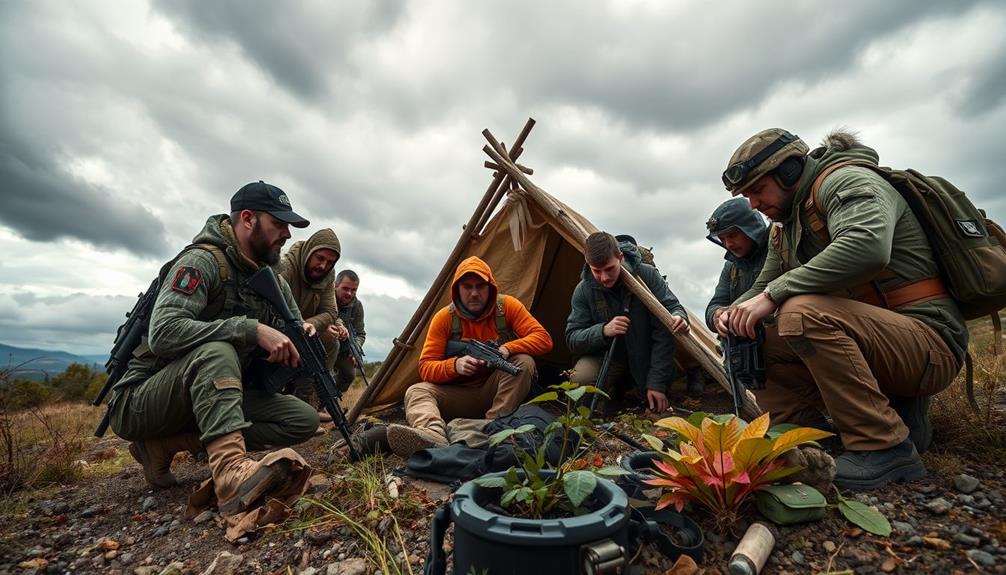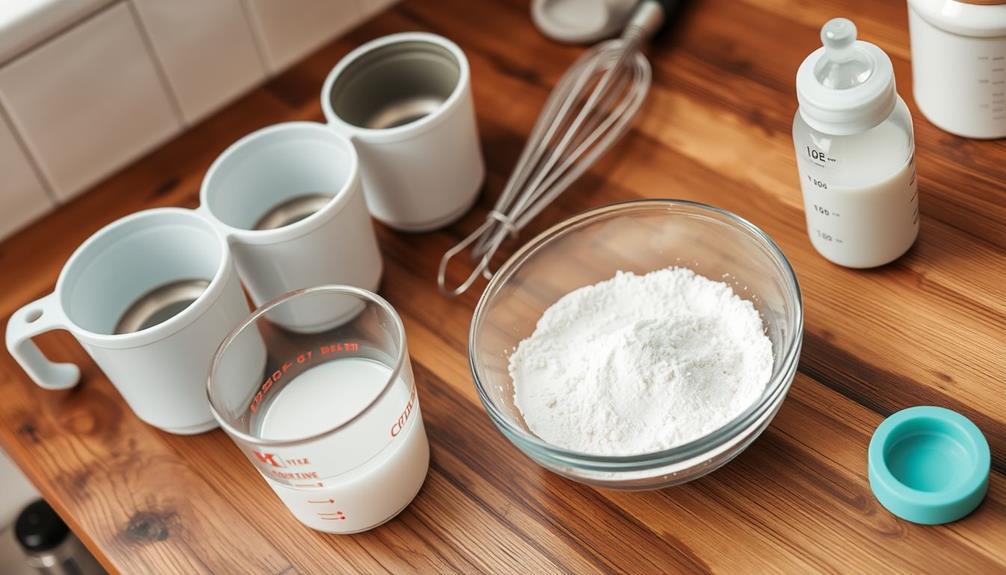When prepping your first aid kit for survival, make sure to include essential supplies. Bandages like ABD pads and stretch gauze are important for wound care. Antibiotics such as Amoxicillin and antiseptics like Betadine help prevent infections. Trauma gear like tourniquets and Israeli bandages aid in emergencies. Stock up on essential medications like eye drops and pain relievers. Including a thorough first aid manual can guide you further. These basics are essential, but there's even more to learn about preparing for unexpected situations.
Key Takeaways
- Include trauma gear like tourniquets, gauze, and hemostatic agents for emergencies.
- Stock vital medications such as antibiotics, eye drops, and pain relievers.
- Ensure a diverse range of supplies like burn gel and cold packs for various medical needs.
- Maintain a thorough medical contact list for quick access during emergencies.
- Prioritize infection prevention with antibiotics, antiseptics, and wound care essentials.
Essential Bandages and Wound Care
Featuring a variety of essential bandages and wound care supplies in your survival kit guarantees you're well-prepared for managing injuries in survival situations. ABD Pads, Eye Pads, Combine Pads, and Sterile Stretch Gauze Bandage Rolls are vital components for proper wound care. These supplies allow you to dress wounds effectively and promote healing in emergency scenarios. Additionally, Waterproof Adhesive Tape in a size of 1/2 x 2.5 yards is essential for securing bandages and dressings firmly in place, ensuring they stay put during movement or activity.
For versatility in managing different wound sizes, non-sterile Stretch Gauze Bandage Rolls in sizes 2, 3, and 4 inches are indispensable. They provide the flexibility needed to wrap and protect various types of injuries effectively. Including a Medical Tourniquet sized at 1 x 18 can be a life-saving addition to your kit, especially for managing severe bleeding promptly and efficiently.
Ensuring your survival kit is well-stocked with these essential bandages and wound care supplies is key to being prepared for any medical emergency in a survival situation.
Antibiotics and Antiseptics

Antibiotics and antiseptics are essential in preventing infections and treating bacterial wounds effectively during emergency situations. In your preppers' first aid kit, including antibiotics like Amoxicillin and Doxycycline can be lifesaving when facing bacterial infections. Remember, it's important to use antibiotics cautiously and seek professional medical advice to prevent misuse and potential resistance.
Alongside antibiotics, antiseptics such as Betadine and hydrogen peroxide are indispensable for cleaning wounds and eliminating germs to reduce infection risks in survival scenarios. Proper storage of these antibiotics and antiseptics in a cool, dry place ensures their potency when you need them most.
Trauma Gear for Emergencies

You must understand Bleeding Control Techniques, master Tourniquet Application Skills, and grasp Wound Dressing Essentials to effectively handle traumatic injuries.
These skills are essential in emergency situations where quick and accurate interventions can make a significant difference in saving lives.
Including these tools and knowledge in your first aid kit can be crucial in preparing for unforeseen emergencies.
Bleeding Control Techniques
To effectively manage severe bleeding in emergency situations, preppers should prioritize stocking their first aid kits with combat tourniquets and other essential trauma gear. Combat tourniquets play a critical role in stopping excessive blood loss quickly.
In addition to tourniquets, gauze rolls and sponges are essential for applying pressure to wounds to help control bleeding effectively. Medical tape is necessary for securing bandages and dressings in place, ensuring they stay put during movement.
Having additional training beyond basic first aid can greatly enhance one's ability to handle traumatic injuries and bleeding emergencies efficiently. Including items like Israeli bandages and hemostatic gauze can further improve bleeding control capabilities in a prepper's first aid kit.
Tourniquet Application Skills
Mastering tourniquet application skills is critical for effectively controlling severe bleeding in emergency situations. Tourniquets play a vital role in stopping excessive blood loss, potentially saving lives when used correctly. To apply a tourniquet properly, place it 2-3 inches above the wound and tighten it until the bleeding stops. Remember to mark the time the tourniquet was applied to provide essential information to medical professionals. Regular training and practice in tourniquet application can significantly improve your readiness during emergencies.
| Tourniquet Application Skills | Importance |
|---|---|
| Proper Placement | Critical |
| Tightening Technique | Vital |
| Time Marking | Essential |
| Training | Crucial |
Wound Dressing Essentials
For effective wound care in emergencies, having essential trauma gear such as ABD Pads, Eye Pads, Combine Pads, Stretch Gauze Bandage Rolls, and Triangular Bandages is vital. These supplies play a significant role in treating various types of injuries and guaranteeing proper wound management.
To secure dressings effectively, waterproof adhesive tape with cloth tape and waterproof adhesion is essential, especially in wet conditions where traditional tapes may fail.
Stretch Gauze Bandage Rolls, available in different sizes, non-sterile, and individually wrapped, are versatile and practical additions to any medical kit.
Additionally, sterile first aid supplies like ABD Pads, Eye Pads, Combine Pads, Stretch Gauze Bandage Rolls, and Triangular Bandages are necessary to maintain a hygienic environment during wound dressing procedures. Including cloth tape in your first aid kit ensures that dressings stay in place securely, enhancing the overall effectiveness of your wound care efforts in emergency situations.
Vital Medications for Survival

Make sure your survival first aid kit includes essential medications like prescription meds, antibiotics, and over-the-counter options to address a variety of health issues in emergency situations. When preparing for survival scenarios, stocking up on important medications is essential.
Here are some key medications to think about adding to your survival first aid kit:
- Prescription medications
- Antibiotics
- Eye drops
- Diarrhea medicine
- Aspirin and ibuprofen
In addition to these essentials, don't forget about allergy medications such as Benadryl to address allergic reactions that may occur during emergencies. Having a well-rounded selection of over-the-counter and prescription medicine ensures you're well-prepared to handle a range of health challenges that may arise in a survival situation.
Comprehensive First Aid Manual

Having a thorough first aid manual in your survival kit is essential to being well-prepared for handling various medical emergencies effectively. This detailed guide provides in-depth instructions on managing different situations such as wound care, CPR, fracture management, and more. In times when professional medical assistance may not be readily available, the first aid manual serves as a valuable reference tool to help you navigate through critical scenarios. By including a detailed first aid manual in your kit, you can boost your confidence and improve your effectiveness in administering essential first aid during survival situations.
| Benefits of a Detailed First Aid Manual | ||
|---|---|---|
| In-depth instructions for medical emergencies | ||
| Guidance on wound care, CPR, and fracture management | ||
| Valuable reference tool in the absence of professional help | ||
| Boosts confidence and effectiveness in administering first aid | ||
| Enhances preparedness for handling medical emergencies |
Additional Supplies for Preparedness

Consider enhancing the versatility of your survival first aid kit by including additional supplies for preparedness. In addition to the essential medical supplies, having a well-rounded kit can better prepare you for unforeseen situations.
Here are five items that can complement your existing supplies:
- SAM Splint: A versatile and lightweight splint that can be molded to fit various injuries, providing support and stability.
- Eye Wash Solution: Essential for flushing out debris and chemicals from the eyes in case of emergencies.
- Tourniquet: Useful for controlling severe bleeding in situations where direct pressure isn't enough.
- Burn Gel: Provides quick relief for minor burns and helps to cool and soothe the affected area.
- Instant Cold Packs: Ideal for reducing swelling and inflammation of sprains, strains, and bruises.
These additional supplies can cater to a wider range of medical needs and emergencies, ensuring you're better equipped to handle unexpected situations effectively.
Importance of Contact List

Including a thorough medical contact list in your first aid kit is essential for quick access to important contacts like doctors and emergency services. In times of crisis, having essential medical contacts readily available can aid in expediting treatment and ensuring prompt communication with the necessary professionals.
Your medical contact list should encompass a range of important information, including primary care physicians, specialists, and emergency hotlines. This list plays a pivotal role in facilitating efficient communication and coordination during emergencies, enabling swift decision-making and effective medical assistance.
Access to medical contact information within your first aid kit is paramount for ensuring that you can promptly reach out to the appropriate authorities and healthcare providers when faced with unforeseen situations. By prioritizing the inclusion of a detailed medical contact list in your first aid kit, you equip yourself with a crucial resource that can greatly impact the outcome of emergency scenarios.
Frequently Asked Questions
What Is in a Survival Medical Kit?
In a survival medical kit, you'll find bandages, antiseptic spray, gloves, and medications for common injuries. For more serious wounds, tourniquets, gauze, and medical tape are essential. Extras like a first aid manual and Mylar blanket can be handy.
What Should I Have in a Personal Survival Kit?
In your personal survival kit, make sure to include bandages, antiseptic spray, gloves, and medical scissors. Add trauma supplies like combat tourniquets, gauze rolls, and medical tape. Medications such as pain relievers and antibiotics are essential.
What Are 10 Items in an Emergency Kit?
You should pack adhesive tape, gauze, bandages, tourniquets, medical tape, antiseptics, antibiotic ointment, hand sanitizer, a whistle, elastic wrap bandages, super glue, and emergency phone numbers in your emergency kit for preparedness.
What Is Essential for Survival Kit?
For survival, essential items in your kit include bandages, antiseptic spray, gloves, and medical tape. Trauma supplies like tourniquets and gauze are vital. Add Israeli bandages, suture thread, and a first aid manual for versatility and readiness.
What essential medical supplies should be included in a prepper’s first aid kit for survival?
When assembling a first aid kit for survival, include essential medical supplies such as bandages, antiseptic wipes, tweezers, scissors, gauze pads, and pain relievers. A preppers medical handbook for survival can also provide crucial information on treating injuries and illnesses in emergency situations. Be prepared for any medical emergency.
What Medical Supplies Should Be Included in a Prepper’s Gear for Survival?
When preparing a preppers gear essential items for survival, it’s crucial to include medical supplies. Basics like bandages, antiseptic wipes, pain relievers, and a first aid manual are essential. Additionally, items like tweezers, scissors, and a thermometer can also be beneficial in a medical emergency.
Conclusion
Now that you have assembled your preppers first aid kit with all the essential medical supplies, you're ready to handle any emergency that comes your way.
Remember, in times of crisis, being prepared can make all the difference between life and death.
So, stock up on those bandages, antibiotics, trauma gear, and medications, and stay one step ahead of the unexpected.
It's better to have it and not need it, than to need it and not have it.










